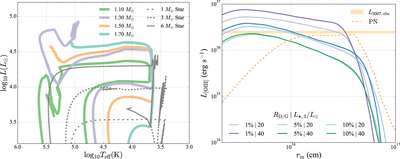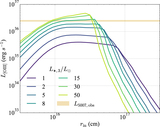Image Details

Caption: Figure 5.
Carbon-oxygen WD merger remnants appear similar to PNe and can produce bright [O III] lines. In the left panel, we show evolutionary tracks (solid lines) of CO WD merger remnants from Schwab (2021) with a binary mass ratio of 0.9 and a range of total masses. For comparison, we overplot on the same panel evolutionary trajectories of typical post-main-sequence single stars (dotted lines) evolved with MESA from Farag et al. (2020). On the right panel, we show WD merger remnants’ L [O III] from CLOUDY simulation as a function of cloud inner radii with a few different R D/G and L ⋆. This is analogous to the PNe version of the plot (Figure 1); we overplot a low-mass star PN model with L ⋆,3 = 5L ⊙ and R D/G = 1% here (dashed line) for comparison. The WD merger remnant nebulae should be brighter than PNe from low-mass stars in old stellar populations unless R D/G ≳ 10%. The orange-shaded region reflects the observed PNLF bright-end cutoff at M 5007 = −4.53 ± 0.06 translated to line luminosity from Ciardullo (2012).
Copyright and Terms & Conditions
© 2023. The Author(s). Published by the American Astronomical Society.







